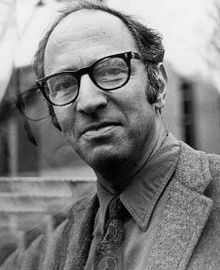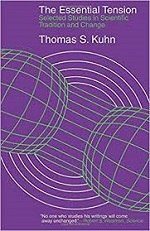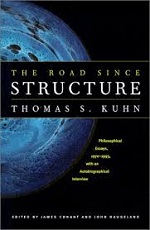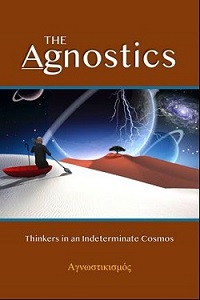|
TRANSLATE THIS ARTICLE
Integral World: Exploring Theories of Everything
An independent forum for a critical discussion of the integral philosophy of Ken Wilber
 David Christopher Lane, Ph.D.
Professor of Philosophy, Mt. San Antonio College Lecturer in Religious Studies, California State University, Long Beach Author of Exposing Cults: When the Skeptical Mind Confronts the Mystical (New York and London: Garland Publishers, 1994) and The Radhasoami Tradition: A Critical History of Guru Succession (New York and London: Garland Publishers, 1992). David Christopher Lane, Ph.D.
Professor of Philosophy, Mt. San Antonio College Lecturer in Religious Studies, California State University, Long Beach Author of Exposing Cults: When the Skeptical Mind Confronts the Mystical (New York and London: Garland Publishers, 1994) and The Radhasoami Tradition: A Critical History of Guru Succession (New York and London: Garland Publishers, 1992).
THE AGNOSTICS
Thinkers in an Indeterminate Cosmos
Introduction |
Isaiah Berlin |
Charles Darwin |
John Dewey |
Enrico Fermi |
David Hume |
Edmund Husserl |
Thomas Henry Huxley |
Thomas Kuhn |
Lynn Margulis |
John Maynard Keynes |
G.E. Moore |
Karl Popper |
Michael Schmidt-Salomon |
Herbert Spencer |
Leo Szilard
THOMAS KUHNShengkai HouThomas Kuhn is one of the most influential sociologists and philosophers of the 20th century working in the history of science In his early academic years, he was uncertain about his major. At first, he started as a physics major student. Later on, he changed it to the history of science. Finally, he majored in philosophy of science. It was near the end of World War II when he graduated from Harvard, so he spent a lot of time on a research project about radar at Harvard; later he went to study it in Europe.  Thomas Kuhn Four years later, after he published his first book, The Copernican Revolution in 1957, Kuhn was hired by the University of California at Berkeley as a full-time professor. This opportunity gave Kuhn a chance to study more about the philosophy of science with the help from his colleagues. Then, in 1962, Kuhn published a new book, The Structure of Scientific Revolutions, which provides a whole new way of interpreting scientific revolutions through a sociological and philosophical lens. In this book, there are 3 key concepts that Kuhn explained: a working definition of science; the development scientific revolutions in relation to the prevailing paradigm of the time; and the impact of incommensurability. All of these concepts are more or less controversial, and some of them have been so wrongly misinterpreted that Kuhn himself (and without irony) had to declare that he is not a Kuhnian. There were many debates on the definition of science around the 20th century. Karl Popper, one of the greatest thinkers in this area, declared that there are 2 kinds of science. The first kind is what people now call the soft science where the scholars in those fields tend to seek pieces of evidence to support their hypothesis; the second kind of science is the hard science, where people establish a hypothesis, and then they try to find evidence to counter their specific claim. On the other hand, Thomas Kuhn's definition of science is that it is a combination, or a collection of facts, theories, and methods (regardless of whether these theories and methods are right or wrong). In The Structure of Scientific Revolutions, Kuhn wrote: “If these out of date beliefs are to be called myths, then myths can be produced by the same sorts of methods and held for the same sorts of reasons that now lead to scientific knowledge. If, on the other hand, they are to be called science, then science has included bodies of belief quite incompatible with the ones we hold today. Given these alternatives, the historian must choose the latter”. In other words, Kuhn is saying that the scientific progress is not bound with the objectively discovered correct answers; instead, it is bonded by a common belief system that the science community holds to be true. Kuhn's idea is a direct rejection of the Popperian perspective, in which the progress of science is a process of being open to various lines of falsification. Nevertheless, Kuhn pointed out a phenomenon that often occurred when the present-day science is in trouble to solve some recalcitrant problems. Normally, scientists tend to use some alternative explanations for the anomaly (or they just ignore the problem for a period) if it cannot be properly explained by their present theories. But if those anomalies keep stacking up, like the dragon in the story of “There Is No Such Thing as a Dragon” by Jack Ken, then there comes a crisis point when such incongruities can no longer be swept under the overly stretched paradigm. Kuhn uses the term 'crisis' to describe the situation when a massive number of scientists fail to continue to believe in their current, overarching modeling system. Originally, people view the development of science as a straight line, which means that scientific revolutions are linear and predictable, but Thomas Kuhn thinks of it as curved trajectory with unexpected ruptures. First, he introduced the term 'paradigm' in The Structure of Scientific Revolutions, which he defined as a combination of 2 conditions. The first condition is when there are enough scientists who are attracted to some new set of perspectives during the exploring period, and the second condition is when this new set of belief systems has left those scientists with a host of new problems to solve that sprout out in differing areas of inquiry. From Kuhn's perspective, the scientific revolution has 3 stages: the status quo or normal science stage, the revolutionary science stage, and then returning to the bounded and predictable science stage. Obviously, normal science stage occurs when the scientists are in a widely accepted paradigm that appears with not too fissures, and the revolutionary science stage occurs when there are enough anomalies to force the previous model to break at the seams. One of the best examples to explain Kuhn's scientific revolution theory would be the history of the development of how to treat schizophrenia. Before biochemistry became well established and developed (around the 1950s), there were lots of doctors who thought schizophrenia was a psychological disease which is caused by the pathological environment that these patients were in. It was not unreasonable for them to assume that because these patients tended to have lots of anti-social behaviors. Therefore, scholars did an enormous amount of studies on the relationship between parenting style (mainly focusing on mothers because fathers in that period appeared to pay less attention to parenting) and schizophrenia, but the statistical reports showed that the parenting style does not affect the chances of getting schizophrenia. After the biochemical field had developed to a certain degree, scientists in biochemistry had successfully developed a new medicine to greatly alleviate this disease. After a short period, about 90% of patients diagnosed with schizophrenia were allowed to leave the hospital. This was a huge shock for the scientists who believed that parenting style has some impact on those patients, and they eventually came to regret what they had done to those parents who believed it was partially, if not wholly, their fault. In this scenario, the original paradigm is the belief that parenting style has an impact on the schizophrenia patients; the crisis is the inefficient results of curing schizophrenia by changing the parenting style, and the final stage is the recognition that schizophrenia is primarily a biochemical disorder. When Kuhn explains the paradigm in The Structure of Scientific Revolution, he specifically mentioned a term-incommensurability, which refers to the difficulties of comparing 2 theories abstractly. In summary, there are three types of incommensurability, including the methodological incommensurability, observational incommensurability, and taxonomic incommensurability. The methodological incommensurability refers to the difficulties of setting up a standard line of empirical measurement in different scientific eras. Not only is it different because of the general paradigm difference in a different period, but it is also influenced by the subjective interpretations from each unique individual who could potentially understand a paradigm, or the standard measurement differently. [However, in order to avoid misinterpretation, it is necessary to claim that this theory does not relate to post-modernism which it declares that things can be interpreted in an infinite amount of ways by each individual.]. Therefore, in an essay “Objectivity, Value Judgment, and Theory Choice”, Kuhn identified the 5 basic elements of the paradigms that people generally used to measure the credibility of theory, including accuracy (can I use it to predict things that might happen in the future), consistency (can I relate this theory to other theories that are currently accepted by the public), scope (can I use this theory to explain something else that can relate to this theory), simple (Is the explanation easy enough for most people to understand this theory), and fruitful (can I use this theory to discover something new). Some people would argue that his explanation on these 5 points is too vague that it can be interpreted in many valid ways, but I think it is reasonable enough if comparing this explanation to the Constitution of the United States. Then, he mentioned the observational incommensurability which serves as a counter-argument against the positivists' point of view on which people who view the competing theories as an arbitrator would create an objective viewpoint. The observational incommensurability is based on the assumption that if 2 people comprehend the conflicting theories from both sides in the same environment, they are going to have different results due to the subjective perception as humans. The taxonomic incommensurability indicates that the languages, as well as the symbolic representations of things, can be shifted over time due to the change of paradigm and the change of the environment. When I was studying about Aristotle, I was often confused when he uses the word 'art' because it is incomprehensible if based on the modern definition of art. Nevertheless, people often find it extremely difficult to read literature from ancient Greek because there are many errors during the translation process. Those examples can be due to the effect of taxonomic incommensurability, but further studies on the issue of incommensurability are still required. Thomas Kuhn's radical repositioning of how we understand science is predicated on the notion that we humans are always pushing the boundaries of what is known and what is unknown. As such his philosophy can be likened to an “agnostic” awakening about the scientific endeavor itself. Science isn't “Knowledge” with a capital K, but rather a human system of moving from one model to the next in order to better understand any given phenomena. It is an approximating map and one which once accepted tends to resist change, just as humans who prefer certainty over uncertainty unless some crisis upends that prior stability. It is, of course, a false or illusory consolation, since as Kuhn opines, ““Normal science, the activity in which most scientists inevitably spend almost all their time, is predicated on the assumption that the scientific community knows what the world is like.” But we what we know is our current modeling systems, which given their tentative nature are never the whole, unadulterated story. The following are a series of pregnant quotes from Kuhn which illustrate his agnostic philosophy with regard to scientific ultimacies. “Truth emerges more readily from error than from confusion.” “The answers you get depend on the questions you ask.” “Under normal conditions the research scientist is not an innovator but a solver of puzzles, and the puzzles upon which he concentrates are just those which he believes can be both stated and solved within the existing scientific tradition.” “To reject one paradigm without simultaneously substituting another is to reject science itself.” “Unanticipated novelty, the new discovery, can emerge only to the extent that his anticipations about nature and his instruments prove wrong.” “Max Planck, surveying his own career in his Scientific Autobiography, sadly remarked that “a new scientific truth does not triumph by convincing its opponents and making them see the light, but rather because its opponents eventually die, and a new generation grows up that is familiar with it.” “What man sees depends both upon what he looks at and also upon what his previous visual-conception experience has taught him to see.”
Further Reading:1. The Structure of Scientific Revolutions 2. The Essential Tension: Selected Studies in Scientific Tradition and Change 3. The Road Since Structure: Philosophical Essays, 1970-1993    FROM THE INTRODUCTION | DAVID LANE
Often in the philosophy classes I have taught in undergraduate and graduate school, I would bring up this point of “unknowingness.” Pointing to a crumpled piece of writing paper, I would ask the class, “What is this?” Almost in unison, the students would respond, "A piece of paper." Taking this as my cue to lead into a deeper philosophical investigation of materialism, I probed further, "Yes, but what is that?” Catching my drift, one student invariably answered, “Oh, it is actually a transformed sheet of wood.” Not wanting them to stop there, I asked, “And wood is made of what?” “It's comprised of molecules," the more scientifically oriented students would shout. Connecting to the now forgotten inner space ride at Disneyland, which takes one through an imaginary voyage inside a snowflake molecule, I queried, “But what is a molecule made of.” By this time, we had gotten down to the subatomic level, and our words began to betray our modicum of knowledge (electrons, protons, quarks, lucky charms, superstring). The final question I asked was quite simple, but given the line of investigation it led to some severe complications: What is matter? Well, it should be obvious to the reader as it was to my class and to myself that there's only one truly appropriate response, “I don't know.” Now, this is exactly the response not only of most mystics, but most quantum physicists as well. As Sir Arthur Eddington, the distinguished astronomer put it, “Something unknown is doing we don't know what!” To be sure, mystics have said that the world (or matter) is nothing but consciousness. But, what is consciousness? Not even a sage as enlightened as Ramana Maharshi of South India could answer that question. To such queries, Ramana would often sit in silence. Ultimately, matter leads to consciousness and consciousness to God or Nature (with a capital N) and both to Mystery. However, no matter how you define it, slice it, categorize it, blend it, intuit it, the fact remains that Reality is a Mystery, and nobody apparently (not me, not you, not Einstein) knows what that Reality is. We are sitting right in the middle of the Mystical Dimension.
Comment Form is loading comments...
|